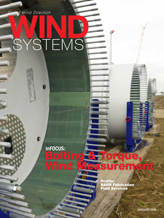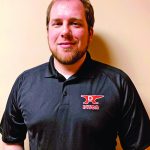What is your title, and what do you do with Williams Form?
My title is West Coast wind sales manager. I’ve been here 11 years, and I quote and sell the bolts. I quote the big projects. And we just supply the tower foundation bolts and caps, but we don’t do any of the rebar or concrete when it comes to wind. Our company does many other things, but just when it comes to the wind towers, we just supply the long tower foundation bolts.
How do you approach a client?
I typically don’t go to the farm until we start supplying it. I’m not hands-on or anything. We’re just the supplier. But we have a lot of knowledge, and if they’re struggling in the field with something, we can typically help them out because of the other civil engineering stuff we do that may or may not apply to what they’re doing in the field. But they come to me. It’s a huge bidding process. Some of these farms I quoted three years ago, and then they’re put on a shelf, and now they’re coming back around. And there are so many players — there are owners, developers, and the money behind it, and the power purchase agreements, and the land leases. So all of that has to come together before the farm can finally go.
What products do you offer the wind industry?
We offer tower foundation bolts and the caps that go on the top for corrosion protection.
How did Williams Form get into the wind industry?
We’ve been supplying these tower bolts consistently for 15 years, maybe 18, but the first three years was in its infancy. We are a bolt supplier. And when I say bolt, I don’t mean a little fast nail bolt. I mean post tension for bridges; we do strand anchors, and so we had a customer way, way back when turbines were lattice towers and they were just dowels. They weren’t a bolt. That’s how we got into it, because these are really a PT application. These bolts are post tension. So, you pull on them, and PT bolts are what we do. So the industry changed from a dowel, which is just like a threaded rod that is concreted into the foundation and then the tower is set on top of it and then they torque the nut down. Now it’s a PT element where its post tensioned, so they set the top down on the bolt, and then they use a hydraulic ram or tensioner and pull on the bolt to a specific load and then lock the nut off. And that’s basically how we got into it once it transferred. We did supply some of the dowels early on, but then the foundation design changed, and we supply that large tension bolt.
What caused that change over?
The machines getting larger and taller. It went from a latticed tower to the tube tower now that you see. So as the machines themselves got larger and larger, and the hub heights got higher and higher, the foundation design changed from a little block with dowels in it to a big spread footing with these PT bolts in it.
What sets Williams Form’s turbine parts above the rest?
We have a lot of industry knowledge. We’ve been doing it for many years. We do have an in-house engineering department. And we have multiple facilities to supply multiple projects. A lot of these contractors do between 10 and 15 foundations a week, which is about two to three full flatbed truckloads. So with our multiple facilities, we can pull that off where a lot of the smaller guys can’t. We have a very good QAQC department, which is part of our in-house engineering department. It’s basically all about supply and quality and being able to meet the contractor’s demands and providing a good product, so these guys don’t have to worry about it in the field.
What challenges have you faced while working with the wind industry?
We haven’t really had any challenges. It’s pretty cookie cutter. Although the farms have been coming quicker and quicker, usually we’d like a two-month lead-time to procure materials and manufacture it and then send it. But a lot of these farms trigger within four weeks that they want material. And that’s a short window.
How do you adjust to that?
We have in-house stock that we can cut from. Wind is probably only 20 percent of what we do — it’s a large 20 percent. But we supply bridges and roadways, so we always have material in-house.
So you create the bolts in-house?
Yes. We create the bolts. The raw material comes from the mill as a smooth bar, and then we cold roll it with a course knuckle thread or a rope thread, which the industry really likes because it’s less susceptible to dinging in the field. Where if it were a fine thread, then you’d have to chase those threads. So basically our thread form, you can scratch it up, ding it up, and it still goes on.
Are all bolts the same?
The lengths change depending on the design from the design engineers. So the bolt diameter can change. Common bolt sizes are an inch and a quarter, an inch and three-eighths, and an inch and three-quarters. And they come in grades of 75, 90, and 150. Depending on the geotech at the site and the height and weight of the machine, the bolt diameter, grade, and length will change. And those three grades and those three dimensions are common, not only in the wind industry, but in foundation work, bridge work, and other areas.
Where do you see wind in 10 years and Williams Form Engineering’s place in it?
If the wind industry is still going strong like it is now, we’ll still be supplying bolts to these farms, certainly. The temperature out there now is that 2018 will be a very busy year.
For more information, go to www.williamsform.com








































